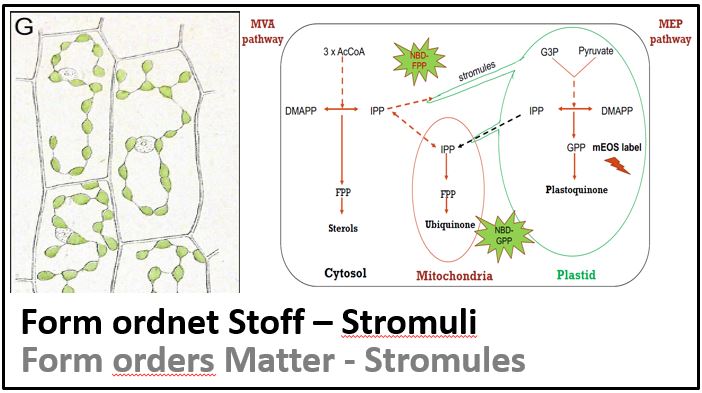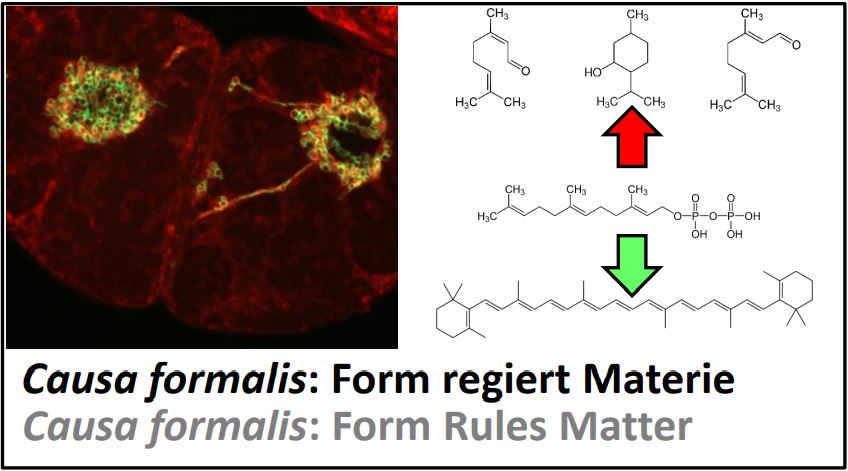 Plant Cell Biology 2024
Plant Cell Biology 2024
Stromules are protrusions formed by plastids under certain conditions. First discovered in the 19th century, they were later forgotten and "rediscoved" in the 1990ies. They were thought to form a network of plastids within the cell, but this was then disproven by the elegant experiments of Martin Schattat and Jaideep Mathur using photoswitchable fluorescent proteins. We want to understand, what stromules are doing and we can show that they are inducible by the jasmonates (plant stress hormones). Since the plastids are the main chemical factories of plants, change of their shape might lead different channelling of metabolic pathways. In other words: form rules matter. Can we test this idea experimentally? Ongoing work has shown that the stromules can be induced by certain hormones, such as methyl jasmonate or salicylic acid and that they need microtubules to be formed, which means, we can disrupt them by the anti-microtubular compound oryzalin. We have already found out that the jasmonate precursor OPDA can be rechannelled by stromules to the mitochondria, such that less is transferred to the peroxisomes (where it undergoes beta-oxidations into the mature jasmonic acid). Since OPDA has meanwhile been recognised as being a hormone by itself, we wonder, whether stromules channel OPDA for a different purpose. We suspect that the target might be mitochondria that are under stress and, therefore, accumulate reactive oxygen species. Are friendly plastids using stromules to "tap on the shoulder" of their stressed fellow mitochondria to calm them down and to help them in coping with oxidative stress? However, we have recently made a second, more shocking discovery: Farnesyl Pyrophosphate (FPP), a precursor of terpenoids that are made in the plastid, does not go straight to its final destination, but first lingers in some structures that look like mitochondria, from where plastids pick it up through stromules. Are stromules fingers that do not give, but take? We are not sure, but using inhibitors of terpenoid pathways to modulate the metabolic flow, we want to find out, whether this is changing the appearance of stromules. This requires to measure shape - not a trivial task, but we have developed a new approach making use of Artificial Intelligence to recognise stromules and to record their morphometry. Background and protocols . Bachelor thesis on stromules .
causa formalis - Form regiert Stoff
Das Bild der Zelle hat sich über die Zeiten stark gewandelt. Während in den 1940er Jahren, als die Biochemie dominierte, Zellen gerne als "bags full of enzymes" gesehen wurden, führte die Erfindung der Elektronenmikroskopie zur Entdeckung komplexer innererer Strukturen von Organellen und Membrankompartimenten. Dies wirkte etwas starr, was freilich dem Umstand geschuldet war, dass man für Elektronenmikroskopie die Zellen chemisch fixieren muss. Erst der Siegeszug der Fluoreszenz- und Konfokalmikroskopie ab etwa 1990 erlaubte es, molekulare Vorgänge in der Zelle dynamisch sichtbar zu machen. Trotz des umfangreichen Wissens um die dynamische Architektur im Innern der Zelle, verfolgt die Molekularbiologie oft ein eher statisches Bild, was auch wieder methodisch bedingt ist - molekulare Genetik liefert eben Daten über den Genotyp eines Organismus, der sich ja nicht verändert. Was noch fehlt, ist eine Synthese aus molekularer Genetik und Zellbiologie. Hier wollen wir ansetzen und zeigen, dass die molekularen Vorgänge im Innern einer Zelle durch Veränderungen der Form gesteuert werden können. Form regiert also Stoff. Als Fallbeispiel haben wir uns die Stromuli ausgesucht, das sind Ausläufer der Plastiden, die sich vor allem unter bestimmten Stressbedingungen ausbilden. Von Schimper schon Ende des 19. Jahrhunderts entdeckt, gerieten Sie später in Vergessenheit und wurden erst in den 1990er Jahren mithilfe von plastidär lokalisiertem GFP wieder entdeckt. Die anfängliche Idee, dass die Plastiden über Stromuli ein Netzwerk bilden, wurde später durch elegante Versuche von Mathur und Schattat widerlegt. Die Stromuli berühren nur andere Plastiden, aber auch andere Organellen wie Mitochondrien oder Peroxisomen. Was die Funktion dieser Stromuli ist, blieb bislang unverstanden. Wir haben uns nun die Jasmonsäurebiosynthese ausgesucht, die im Plastiden beginnt und dann im Peroxisom fortgesetzt wird. Wir vermuten, dass die Stromuli den Metabolismus umlenken können, so dass sich eine Vorstufe der Jasmonsäure, OPDA, anreichert, die eine eigene Signaltransduktion besitzt. Unsere Idee ist also, dass die Zelle abhängig von den Bedingungen, metabolische "Entscheidungen" trifft und dass diese über Formänderungen des Plastiden umgesetzt werden.

